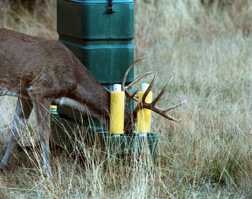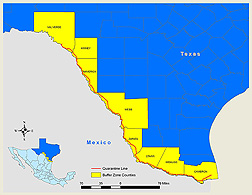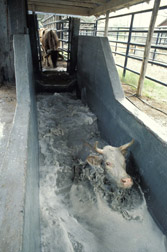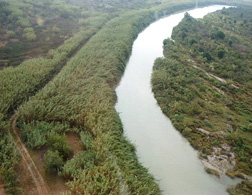The Continuing Fight Against Cattle Ticks
Tick fever once crippled the U.S. cattle industry. The disease was eradicated here in 1943, but ticks that transmit it are still found in Mexico. Keeping them from crossing the border requires constant vigilance, with strict inspection standards and pesticide treatment of all live cattle imported from Mexico.
The southern cattle tick, Boophilus microplus, and the cattle-fever tick, B. annulatus, transmit the two species of blood parasites, Babesia bovis and B. bigemina, that cause the cattle diseases collectively known as “Texas fever,” “cattle fever,” or “bovine babesiosis.” Texas fever can kill up to 90 percent of yearling and adult cattle. Cattle infected as calves with Babesia normally do not develop debilitating disease but may be less healthy than uninfected animals.
In 1938, as part of the USDA Cattle Fever Tick Eradication Program (CFTEP), a permanent quarantine area, or buffer zone, was established in southern Texas in a narrow, 500-mile-long area along the Rio Grande River. When outbreaks occur in the quarantined area, ticks are eradicated by CFTEP inspectors in cooperation with the Texas Animal Health Commission.
For almost 49 years, the ARS Knipling-Bushland Livestock Insects Research Laboratory in Kerrville, Texas, along with its satellite worksite at Moore Field in southern Texas, has been charged with providing technical support to CFTEP.
Wildlife Carriers
Since the buffer zone was created, the number of fever-tick introductions there has varied from year to year, but a significant increase has occurred over the past 5 years. In addition, an alarmingly large increase in the numbers of fever-tick infestations in the so-called tick-free area north of the buffer zone has been recorded in recent years.
Prime tick carriers are the hoofed, or ungulate, wildlife species, which abound in southern Texas and northern Mexico. White-tailed deer, American elk, and European red deer are all known carriers of B. microplus and B. annulatus ticks. Adding to the problem is a great increase, over the past few decades, in importation of exotic wildlife, which has brought hundreds of thousands of other animals, representing at least 67 species, into Texas.
In southern Texas, white-tailed deer are the most important alternative hosts for cattle fever ticks. In 2004, deer were associated with B. annulatus infestations of a cluster of ranches in the tick-free area of Kinney County, Texas. In the buffer zone on a ranch in Starr County, 19 of 25 white-tailed deer captured were infested with B. microplus. Similar incidents occurred in 2005 in Maverick County and in 2006 in Webb County in which ticks were found on cattle after being found earlier on deer.
|
|
A Simple Design Does the Trick
To combat spread of ticks by wildlife, Kerrville scientists developed and patented a device they call a “4-poster.” It has a bin in the center from which small amounts of whole-kernel corn enter feeding ports located near each end of the device. When a deer inserts its muzzle into a port to feed, it must tilt its head and neck in a way that forces contact with a pair of paint rollers saturated with pesticide. Later, when the deer grooms itself, the pesticide spreads enough to protect its entire body.
Initially created to combat the lone star tick, Amblyomma americanum, and the deer tick, Ixodes scapularis, which spreads Lyme disease, the 4-poster is now being tested for use against cattle fever ticks on deer.
Mat Pound, a Kerrville entomologist, tested a specially formulated acaricide, containing 10 percent permethrin, to treat tick-infested white-tailed deer. Pound’s data were essential to gaining approval by the U.S. Environmental Protection Agency to market the product, named “Tickicide,” to be used only with the 4-poster. Initial results indicate that the 4-poster will be useful for controlling cattle fever ticks on white-tailed deer.
Another technology developed at the Kerrville laboratory is a method of feeding deer whole-kernel corn treated with ivermectin or other systemic acaricides. It has often been used on ranches to eradicate ticks on deer once the cattle have been moved to another location.
“Use of ivermectin-treated corn and 4-poster technology is vital to the ongoing campaign to eradicate cattle-fever ticks introduced to southern Texas on hosts such as cattle, horses, white-tailed deer, or exotic ungulate wildlife that come across the Rio Grande from Mexico,” says entomologist John George, who leads the research at Kerrville. “By using all our resources and knowledge, it will be possible to minimize or eliminate ticks on white-tailed deer and other ungulate wildlife, keeping U.S. cattle free of Texas fever.”
New Ways To Beat Resistance
An important factor working against eradication is that some populations of southern cattle ticks in Mexico have evolved resistance to acaricides, and those resistant strains are spreading into southern Texas.
Boophilus tick control on U.S. cattle relies exclusively on treating the livestock with coumaphos, an organophosphate acaricide. But a recent ban on many organophosphate chemicals—plus a growing prevalence of resistance in many Mexican tick populations to organophosphates—is creating a critical need for effective alternatives.
At the Moore Field laboratory, researchers have tested a new formulation that uses spinosad, which is derived from a soil organism. They sprayed the spinosad, at 3-week intervals, all over B. annulatus-infested cattle, using two different concentrations—0.05 percent and 0.08 percent.
For comparison, untreated cattle were kept in a pasture beside the one with the treated animals, and tick counts were done at various intervals. In the pasture with treated cattle, the tick population declined, while ticks on untreated cattle increased. This suggests that spinosad application would be a useful addition to a tick-control program.—By Alfredo Flores, Agricultural Research Service Information Staff.
This research is part of Veterinary, Medical, and Urban Entomology, an ARS National Program (#104) described on the World Wide Web at www.nps.ars.usda.gov.
John E. George is at the USDA-ARS Knipling-Bushland U.S. Livestock Insects Research Laboratory, P.O. Box 232, Kerrville, TX 78028; phone (830) 792-0304, fax (830) 792-0302.
"The Continuing Fight Against Cattle Ticks" was published in the June 2006 issue of Agricultural Research magazine.










